 Taxidermy supplies and tips
Taxidermy supplies and tipsLearning taxidermy
History of taxidermy
Bird taxidermy
Skinning and cleaning bird
Construct artificial body<
Mount bird skin
Bird study cabinet
Mounting small and medium birds
Mounting large birds
Coyote taxidermy
Deer taxidermy
Fish taxidermy
Muskrat taxidermy
Squirrel taxidermy
Taxidermy panels and shields
Making animal fur rugs
Taxidermist hunting
Taxidermy mounting kits
Other resources
Construct artificial body
With the skin preparation completed, construction of an artificial body is the next step. In all bird work, upholstery excelsior or " woodwool" will be found most satisfactory for body making and neck, wing, and leg wrapping.
This may be found at almost any upholstery shop, as is also tow, a fine grade of which is needed in making bird necks, as chopped, soft
filling, etc.
A good grade of long-fiber cotton is needed for wrapping skulls and wing and leg bones in small birds, etc.
Various sizes of strong thread, both black and white, and some small, strong, ball twine will be needed for wrapping and sewing.
When making the artificial body, lay the outline sketches before you and copy nature's lines throughout the work of assembling the
specimen.
To make a firm core for the body, take a thick wisp of excelsior twice the length of the natural body and small or large according to
specimen. Hold this tightly in the left hand, wrapping it very hard with thread or cord. Wrap the squeezed excelsior where it protrudes from between thumb and forefinger of left hand, drawing cord tight at each round, paying out the wisp until all is wrapped hard.
(see Fig. 3 ) .
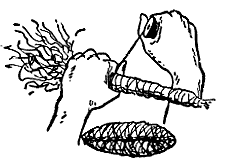
Now double this " stick " of excelsior in the middle and bind it together tightly. This forms a solid core the length of the body.
The body is finished around this base by firmly binding upon it wisps or handfuls of loose excelsior until the shape of the natural
body is approximated.
To be correct this form should appear oval from side view and pear-shaped from end view (see Fig. 4).
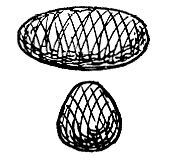
All body wrapping must be firm so that wires set in it will not be loose and cause the specimen to wobble.
Next cut the neck, wing, and leg wires. Cut neck wire three times natural length, wing wires, twice natural length, and leg wires three times,natural length. In the neck use a size wire
that will support the head firmly and still be
easy to manipulate.
If the wings are to be closed, use light wire in them. If to be spread, use strong wire to support with no wobbling. In the legs use as large wire as will go easily through the tarsus and not rip the skin open, to insure rigidity in the finished specimen. Use galvanized soft steel wires if possible. If ordinary black iron wire is used it should be waxed before placing.
For the tail cut one wire of a length to go half way through the body and leave enough protruding to allow of handily setting tail into position. Cut six or eight medium wires, twice length of thickness of body, for wing pinning and feather wrapping, if either or both of these are found necessary. Make cornered points on wires. Sharpen neck- and wing-wires at both ends, leg, tail, and pinning wires at one end.
To set neck-wire in body, thrust it in a little above center of larger end of body, run it diagonally through and out at middle back (see Fig. 5)
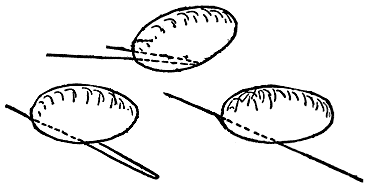
Push two-thirds its length out of back, loop one-third back along its own length and push it back through body so that both ends
protrude, shorter end beneath other in front.
Bend the short end squarely and force it into front of body to anchor: neck-wire firmly in place. Consult note sketch and wrap a soft neck of natural size upon the wire (see Fig. 6).
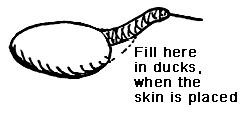
Leave head end of neck a little bit long to set into brain cavity for solid anchorage. For neck material use cotton in small birds, tow in medium size, and fine excelsior in large birds. Only excelsior will need tying down with thread or cord.
To make cords in nape of neck, which support the mane, thread a large sewing needle with heavy thread for small birds, a darning
needle with string for larger. Double the cord and knot its end heavily. Run the needle through ridge of body just back of shoulders, carry cord to a little below where skull will set
to and run cord through neck from back to front so it will protrude between jaws when they are set (see Fig. 7 )
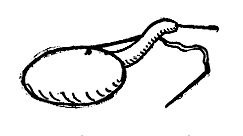
Let long end of cord hang free so that it may be passed through the mouth when skull is set on neck-wire. With this done, lay aside the body.
The next step is wiring the wings and legs and substituting muscles of same. To place a wing-wire draw the wing inside out. Take wing bone in left hand. Place point of wire under small tendon that draws across back of elbow joint, push through and up to wrist. Turn
wing right side out and by parting feathers on under side of wrist, locate two points of bone at joint which have a cord or tendon drawn
Fig. 8.
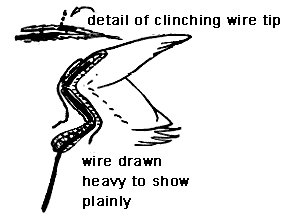
across between them. Work the wire through under this.
The simplest way to anchor tip of wing-wire is to push it outside skin just forward of wrist, turn a short rightangle bend near its tip with pliers and carrying it forward, push the point through a hollow pan which will be found in the hand bones (see Fig. 8).
After a wing-wire is set, wrap cotton, tow, or excelsior about the upper arm-bone to approximate shape and size of flesh removed. Wrap slightly with thread or cord and tie.
In a small bird in which the forearm was skinned out from the inside, slip in a film of cotton or tow to replace flesh of same. In a large bird in which the wing was opened along forearm and hand, lay in a soft filling after skin is in place on artificial body and sewn up.
Sew wing incision carefully, beginning at body and keeping feathers out of stitch. To place the leg-wires, start sharpened end into ball of foot, push wire upward through back of leg to hock or heel joint. Take leg in left hand, keeping heel straight, and push wire through at back of joint. A little turning of the wire will aid in passing through leg easily.Now turn leg inside out and push wire to
just beyond end of shin bone (see Fig. 9).
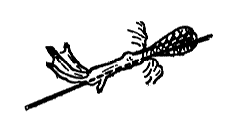
Slip wire rapidly back and forth in leg to make it run easily. There should be no kinks in wires. Hold wire down to back of bone and wrap
on cotton, tow, or excelsior, according to size of bird, to replace flesh. Tie this material loosely with a few turns of thread or cord.
See that wing and leg wrapping is smooth and nicely tapering from elbow and heel.
It now remains to place the body, set wings and legs and tail, sew up the breast incision, and, if a large bird, the wings. In preparing to place the body, take a, turn of end of nape cord about tip of neck-wire and twist a wisp of cotton about them both to prevent wire catching in neck skin when passing through. Hold up the bird-skin by the head, shake it out loose and rattle neck-wire up
through the neck. Run wire out of mouth, remove cotton and release free end of nape cord. Draw wire back to base of skull, leaving nape
cord hanging from mouth. Now push wire through brain cavity, between eye sockets and forward out of roof of mouth inside until neck is seated in brain cavity. Tip of wire may have to be curved to accomplish this, in curve-billed birds.
When head is set take excelsior body in right hand, hold it with head up, and with left hand pull shoulder skin into place. Now lay the bird down, take a wing-wire and start it through the body at side of back, one-half to one and one-half inches, according to size of bird, to rear of actual position of shoulder joint. Pull wire through on opposite side of breast. When head of wing-bone is drawn down to same distance as above, from body, bend wire sharply forward to lay upon body, thus setting shoulder joint so that it is flexible. Now turn over end of wire left protruding from side of
breast and clinch it into body squarely. When wings are set shake skill down over body and set legs.
Having previously marked the hip joint with a spot of ink, run a leg-wire through at this point, quartering it out on opposite side where
thigh will set. Pull wire through to a considerable length without drawing other end up into the foot.
Loop sharp end squarely, with long enough point to go clear through body again, push it back through, clinching tip down on other side.
Now pull the knee to its proper distance from hip joint, thus leaving bare wire for thigh bone. Bend thigh into place flat against side of body, with knee at side of breast.
When legs are set shake and carefully pull skin of rump into place. Take tail-wire and push it through center of tail, under the bone,
using care that it does not disturb tail quills. Push sharp end of wire into body above center and forward of end of body.
Consult notes for actual set of tail. See that wire supports tail without looseness. (For general details of wiring, see Fig. 10 )
Fill butt of tail and thighs with a little chopped tow.
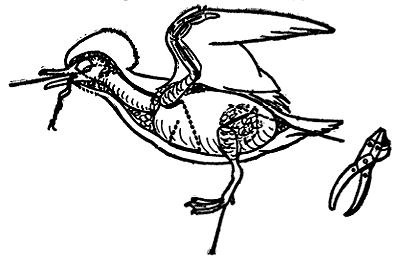
Now lay the bird upon its back. Turn the legs out at the sides a little, leaving knees against body. Draw edges of skin together
along incision and sew up with medium stitches, neither short and labored or long and slouchy. Begin at rump end of incision.
In a bird in which the neck was opened to accommodate skinning the head, sew up this incision carefully, beginning at body end and
sewing toward head.
When a large bird, in which the wings were opened for cleaning, is to be mounted with closed wings, very little sewing need be done, but if the wings are to be raised or spread the incision should be neatly stitched its entire length.
Also in a large bird, in which the tendons were drawn through ball of foot, the fatty tissue of the ball should be replaced with chopped tow and the short incision sewn up. Beeswax will keep thread from fraying.
With the sewing all done, bend the legs into semi-position, fold the wings, if to be closed, and turn them sharply up over the back so that their under side is outward and elbows meet over center of back. Shake out the plumage a little by grasping the feet. Drill the perch and mount the bird upon it. Position the legs, body, and head, and set the tail as per Nature, to suit the position.
Adjust the plumage a little with tweezers. Compress the wings loosely to the sides. If there is an unnatural hollowness between the shoulders, lift the mane and at one side of it where the skin is bare, make a short longitudinal incision. Through this place a little soft filling over and between the shoulders to fill out hollowness. It is not necessary to sew up this incision in a long feathered specimen. Now settle down to the fascinating task of
adjusting the feather tracts, nicely manipulating the plumage, in places feather by feather, until characteristic markings of the species are brought out in their normal position as though
the bird had just ruffled and then allowed the feathers to settle back softly. Jewelers' tweezers are the finest thing to be had for this work.
Return to the head. Pull the nape cord taut and tie it to neck-wire in roof of mouth. Cut off the wire within the mouth so that the man-
dibles close naturally. Tie the bill shut with cord or thread. It is necessary in many specimen's to thread the cord through the nostrils to accomplish this.
To set the eyes, wipe a drop of liquid glue
into the cotton of the eyesockets and inside the
lids, using a bit of wire for the purpose. Set
the eyes with regard to expression to suit the
position, picking the lids over their edges with
needle and tweezers.
Pin, or tie with thread, the toes to grasp the
perch.
Cut two pieces of thin cardboard for the tail. Curve them slightly. Place one over and one under the long quills just clear of the coverts and pin them through in two or three places to hold the quills even until dry.
In mounting a specimen with spread wings, card the flight feathers full length with curved strips, same as tail, then run a long sharpened wire into the body under each wing and lay a loose bunch of cotton over it, under the quills, to raise them and hold in proper position until dry.
To wrap the body feathers for keeping place until dry, stick two or three long pins in back and breast, along center of both. These hold
the light wrapping of thread from slipping out of place as it goes on. Lay the thread around the specimen lightly. If the wings do not set right without other aid than the wire already in them, pin them with sharpened wires, one through the double bone just forward of the wrist and one through close forward of the elbow, running wires firmly into the body. (For
general details see Fig. 11.)
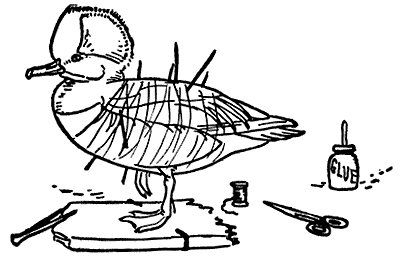
If you have carefully followed all steps you shoud now be done.
Read further for a few important tips on using dried bird skin for mounting

